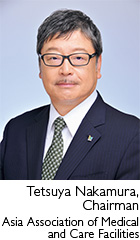From the Chairman
The World Health Organization (WHO) defines “elderly” as persons who are 65 years old or older. When the percentage of elderly persons exceeds 7% of the total population, the country is said to have an “aging population” or a “graying society”. A population in which 14% or more of the people are elderly is defined as an “aged society”, and if 21% or more are elderly, the population is said to be a “super-aged society”.
Japan met the criteria for an aging society in the 1970s, and became an aged society in 1994. Japan’s elderly population has been increasing at a rate far faster than those of other advanced countries like Sweden and France, for instance. This is partly because, as Japan’s economy has advanced, people are getting married later and having fewer children, and also because advances have been made in medical care for the elderly. This has led to a society with an overly large population of elderly citizens, a phenomenon that is occurring not only in Japan, but also, for the same reasons, in Korea, Taiwan, China, Thailand and other Southeast Asian countries.
In view of these circumstances, the 1st Asian Congress of Medical and Care Facilities was held in Kyoto in March 2010, to discuss ways to handle issues faced by Asian countries in which economic growth has provoked decreasing birth rates and elderly populations. It proved an enormous success, with large numbers of participants from both Japan and abroad. In Japan, which became a super-aged population in 2007, when the percentage of elderly reached 21.5%, there is a growing emphasis on acute care. Long-term care is viewed as a field in which medical care is provided to patients requiring long-term treatment, such as patients with lifestyle-related illnesses, and to the elderly, disabled, and other people who may be bedridden or otherwise incapacitated. With Japan now experiencing lower birthrates and an aging population, greater awareness of long-term medical care is called for.
The 2nd Asian Congress of Medical and Care Facilities was held in June 2011 in Pusan, given that Korea is second only to Japan in the speed at which its population is aging. This rapid rate of aging is posing critical problems for Korea as well, underscoring the growing necessity for long-term medical care.
Because aging societies are a problem throughout Asia as a whole, the Asia Association of Medical and Care Facilities was established for the purpose of directly examining the current state of graying societies and considering the medical care necessary in order for the elderly to live with dignity and to lead better, more satisfying lives. From the outset, the Association decided to open membership only to groups that were dedicated to long-term medical care, and obtained the agreement of the Japan Association of Medical and Care Facilities (chairperson: Yozo Takehisa) and the Korean Association of Medical Care and Facilities (chairperson: Deok Jin Kim) in tailoring its memberships to these entities. The Association was founded on July 1, 2011.
Recently, the China Association of Medical and Care Facilities has joined hands with us. Taiwan is becoming an aging society, while other Asian nations, such as Thailand and Singapore, are experiencing rapid aging of their populations. I hope that, in the future, individuals and groups from these nations will also join the Association, so that together we can explore optimum approaches to post-acute medical care from a comprehensive standpoint that includes not only acute-phase care, but all other phases as well.


